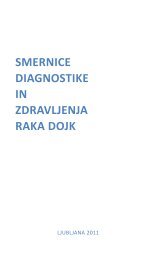You also want an ePaper? Increase the reach of your titles
YUMPU automatically turns print PDFs into web optimized ePapers that Google loves.
A three-dimensional in vitro model to study invasion<br />
Verena Amberger-Murphy, Paula Kinsella, Lisa Murphy, Naomi Walsh<br />
and Martin Clynes<br />
National Institute for Cellular Biotechnology, Dublin City University, Dublin 9, Ireland<br />
Invasion and cell migration of tumour cells is one of the major problems in cancer<br />
treatment. In particular malignant primary brain tumours are characterized by<br />
extensive infiltration of the surrounding normal brain tissue and invasion as far<br />
as the other hemisphere. This extensive tumour spread inevitably leads to tumour<br />
recurrence even after radical surgical resection. It is, therefore, important to achieve<br />
a better understanding of the mechanisms involved in cell migration and invasion.<br />
Most animal models for brain cancer, in particular, fail to produce invasive tumours;<br />
therefore, good in vitro models are needed.<br />
The three-dimensional invasion model is based on the implantation of either<br />
multicellular spheroids or tumour explants into a collagen type I matrix. Cell invasion<br />
into the surrounding collagen is monitored over several days/weeks.<br />
This model offers the possibility<br />
• To qualitatively and quantitatively study invasive behaviour of normal and<br />
tumour cells.<br />
• To investigate the influence of extracellular matrix molecules on cell invasion,<br />
• To test the effect of inhibitors/drugs/drug combinations on cell invasion and<br />
survival.<br />
The gels can be fixed and embedded into paraffin for further histochemical or<br />
immunohistochemical staining.<br />
60l42<br />
We will present a variety of data using this three-dimensional invasion model:<br />
• Invasion activity of fresh tumour explants in relation to their grade of<br />
malignancy<br />
• Invasion activity of primary and established cell lines in the presence and<br />
absence of inhibitors/drug/drug combinations.<br />
This invasion model has been tested with brain tumour explants and cell lines<br />
originating from various tumours, e.g. lung, pancreas, brain. It is a fast and easy<br />
method, which produces consistent data on cell invasion activity.

















